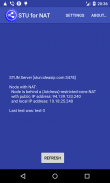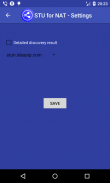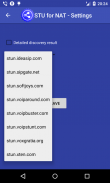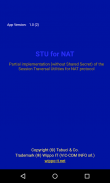








STU for NAT

Deskripsi STU for NAT
There are several ways of implementing network address and port translation. In some application protocols that use IP address information, the application running on a node in the masqueraded network needs to determine the external address of the NAT, i.e., the address that its communication peers detect, and, furthermore, often needs to examine and categorize the type of mapping in use. Usually this is done because it is desired to set up a direct communications path (either to save the cost of taking the data via a server or to improve performance) between two clients both of which are behind separate NATs.
For this purpose, the Simple traversal of UDP over NATs (STUN) protocol was developed (RFC 3489, March 2003). It classified NAT implementation as full-cone NAT, (address) restricted-cone NAT, port-restricted cone NAT or symmetric NAT and proposed a methodology for testing a device accordingly. However, these procedures have since been deprecated from standards status, as the methods are inadequate to correctly assess many devices. New methods have been standardized in RFC 5389 (October 2008) and the STUN acronym now represents the new title of the specification: Session Traversal Utilities for NAT.
Ada beberapa cara pelaksanaan alamat jaringan dan terjemahan port. Dalam beberapa protokol aplikasi yang menggunakan informasi alamat IP, aplikasi yang berjalan pada node dalam jaringan menyamar perlu menentukan alamat eksternal dari NAT, yaitu, alamat yang rekan-rekan komunikasinya mendeteksi, dan lebih jauh lagi, sering perlu untuk memeriksa dan mengkategorikan jenis pemetaan yang digunakan. Biasanya ini dilakukan karena yang diinginkan untuk membuat sebuah jalur komunikasi langsung (baik untuk menghemat biaya mengambil data melalui server atau untuk meningkatkan kinerja) antara dua klien yang keduanya berada di belakang Nat terpisah.
Untuk tujuan ini, traversal sederhana dari UDP lebih Nat (STUN) protokol dikembangkan (RFC 3489, Maret 2003). Ini diklasifikasikan implementasi NAT sebagai full-kerucut NAT, (alamat) dibatasi-cone NAT, port-dibatasi kerucut NAT atau simetris NAT dan mengusulkan metodologi untuk pengujian perangkat sesuai. Namun, prosedur ini telah sejak ditinggalkan dari status standar, sebagai metode yang memadai untuk benar menilai banyak perangkat. Metode baru telah dibakukan dalam RFC 5389 (Oktober 2008) dan STUN akronim sekarang merupakan judul yang baru dari spesifikasi: Sesi Traversal Utilitas untuk NAT.


























